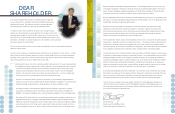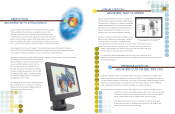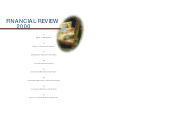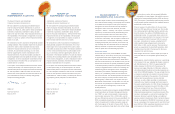Computer Associates 2000 Annual Report Download - page 12
Download and view the complete annual report
Please find page 12 of the 2000 Computer Associates annual report below. You can navigate through the pages in the report by either clicking on the pages listed below, or by using the keyword search tool below to find specific information within the annual report.
20
Unsecured and uncommitted multicurrency lines of credit are
available to meet any short-term working capital needs for
subsidiaries operating outside the U.S. These lines total U.S.
$50 million, of which $14 million was drawn at March 31, 2000.
Debt ratings for the Company’s senior unsecured notes and
its bank credit facilities are BBB+ and Baa1 from Standard &
Poor’s and Moody’s Investor Services, respectively. The
Company has also received A2 and P2 ratings from Standard
& Poor’s and Moody’s Investor Services, respectively, for its
anticipated commercial paper program. Peak borrowings under
all debt facilities during fiscal year 2000 totaled approximately
$5.7 billion with a weighted average interest rate of 6.6%.
To date, the Company has purchased approximately 150
million shares under its various open market Common Stock
repurchase programs. The remaining number of shares
authorized for repurchase is approximately 50 million.
In addition to expansion efforts at its U.S. headquarters in
Islandia, New York, capital resource requirements at March
31, 2000 consisted of lease obligations for office space,
computer equipment, mortgage or loan obligations, and
amounts due as a result of product and Company acquisi-
tions. Refer to Notes 6 and 7 of Notes to Consolidated
Financial Statements for details concerning commitments.
Additionally, the Company may be required to make tax pay-
ments of approximately $80 million related to the settlement
and the return to the Company of 4.5 million shares of its
common stock associated with the 1995 Plan. See Note 7 of
Notes to Consolidated Financial Statements for additional
information. It is expected that existing cash, cash equiva-
lents, marketable securities, the availability of borrowings
under credit lines, and cash provided from operations will be
sufficient to meet ongoing cash requirements.
Interest Rate Risk
The Company’s exposure to market risk for changes in inter-
est rates relates primarily to the Company’s investment port-
folio, debt, and installment accounts receivable. The Company
has a prescribed methodology whereby it invests its excess
cash in debt instruments of government agencies and high
quality corporate issuers (generally Standard & Poor’s single
“A” rating and higher). To mitigate risk, many of the securities
have a maturity date within one year, and holdings of any one
issuer excluding the U.S. Government do not exceed 10%.
Periodically, the portfolio is reviewed and adjusted if the credit
rating of a security held has deteriorated. The Company does
not utilize derivative financial instruments.
The Company maintains a blend of both fixed and floating rate
debt instruments. At March 31, 2000, the Company’s total
outstanding debt approximated $5.4 billion. Of this amount,
approximately $2.1 billion was comprised of fixed rate obliga-
tions; the remaining $3.3 billion was floating rate debt. If mar-
ket rates decline, the Company could be required to make
payments on the fixed rate debt that would exceed those
based on current market rates. Each 25 basis point decrease
in interest rates would have an associated annual opportunity
cost of approximately $5 million. Each 25 basis point increase
or decrease in interest rates would have an approximately $8
million annual effect on variable rate debt interest based upon
the balances of such debt at March 31, 2000.
The Company offers financing arrangements with installment
payment terms in connection with its software solution sales.
The aggregate contract value includes an imputed interest ele-
ment, which can vary with the interest rate environment. Each
25 basis point increase in interest rates would have an asso-
ciated annual opportunity cost of approximately $15 million.
Foreign Currency Exchange Risk
The Company conducts business on a worldwide basis
through subsidiaries in 44 countries. The Company is there-
fore exposed to movement in currency exchange rates. As
part of its risk management strategy and consistent with prior
years, the Company did not enter into any foreign exchange
derivative transactions. In addition, the Company manages
its level of exposure by denominating international sales and
payment of related expenses in the local currency of its sub-
sidiaries. A 1% decline in all foreign currencies against the
U.S. dollar would have an insignificant effect on the
Company’s net income.
Equity Price Risk
The Company has a minimal investment in marketable equity
securities of publicly-traded companies. At March 31, 2000,
these investments were considered available-for-sale with any
unrealized gains or losses deferred as a component of stock-
holders’ equity. It is not customary for the Company to make
investments in equity securities as part of its investment
strategy.
The Company has publicly identified products that have not
been and will not be updated to be Year 2000 compliant and
has encouraged clients using these products to migrate to
compliant versions/products. In general, these Year 2000
compliance efforts have been part of the Company’s ongoing
software development process. As such, incremental costs
are not deemed material and have been included in product
development and enhancement expenses. There can be no
assurances that the Company’s compliant products do not
contain undetected problems associated with Year 2000 com-
pliance. Although the Company believes that its license agree-
ments provide it with protection against liability, the Company
cannot predict whether, or to what extent, any legal claims will
be brought, or whether the Company will suffer any liability as
a result of adverse consequences to its customers. Addition-
ally, the Company adopted a Millennium WatchSM plan whereby
clients around the world were provided with 24-hour on-site
and in-house technical support from December 27, 1999
through January 7, 2000. The Company extended the sched-
ules of the internal administrative and facility-related staff to
support the infrastructure during the Millennium Watch. The
plan resulted in approximately $8 million of additional expen-
ditures over the period.
The Company has recognized the significance of the Year
2000 issue as it relates to its internal systems including IT
and non-IT systems, and understands that the impact extends
beyond traditional hardware and software to automated facility
systems and third-party suppliers. The total cost of preparing
internal systems to be Year 2000 compliant has not been and
is not expected to be material to the Company’s operations,
liquidity, or capital resources. Total known expenditures,
excluding personnel costs of existing staff, related to internal
systems’ Year 2000 readiness were approximately $30
million. Such expenditures commenced in 1996.
Demand for certain of the Company’s products was generated
by customers who were replacing or upgrading computer sys-
tems to accommodate the Year 2000 date change. Following
the date change, demand for some of the Company’s prod-
ucts diminished.
Liquidity and Capital Resources
Cash, cash equivalents, and marketable securities increased
$851 million from the March 31, 1999 balance of $536 mil-
lion to $1,387 million at March 31, 2000. Cash and invest-
ments associated with Sterling represented approximately
$475 million of the year-end balance.
Year-to-date cash generated from operations was $1,566
million, an increase of 24% from the prior year. The Company
used its cash from operations primarily to fund acquisition
costs and for debt reduction. The primary source of cash for
the year was higher net income adjusted for non-cash charges.
Other sources of cash included strong collections of outstand-
ing accounts receivable and the Company’s decision, in the
fourth quarter, to assign selected existing installment accounts
receivable to a third party. The Company may continue to ex-
plore the use of financing companies as a means of expediting
debt reduction, mitigating interest rate risk, and reducing
installment accounts receivable balances.
As part of its acquisition of PLATINUM in May 1999, the
Company terminated its revolving credit lines and replaced
them with $4.5 billion of committed bank financing. This
financing consisted of a $1.5 billion 364-day revolving credit
facility, a $1 billion four-year revolving credit facility and a $2
billion four-year term loan. Borrowings on these facilities for
fiscal year 2000 totaled $3.620 billion and were used to pur-
chase the outstanding shares of PLATINUM and fund related
shut-down costs. The Company repaid $425 million of this
amount during the year. At March 31, 2000, $3.195 billion
remained outstanding at various interest rates. Interest is
determined based on a bank facility ratings grid which applies
a margin to the prevailing London InterBank Offered Rate
(“LIBOR”). In May 2000, the Company renewed the 364-day
revolver, for a total of $4.3 billion in committed bank facilities.
The Company also utilizes other financial markets in order to
maintain its broad sources of liquidity. In fiscal year 1999, the
Company issued an aggregate of $1.75 billion of unsecured
Senior Notes. Amounts borrowed, rates and maturities for
each issue were $575 million at 61
/
4% due April 15, 2003,
$825 million at 63
/
8% due April 15, 2005, and $350 million
at 61
/
2% due April 15, 2008. $256 million also remains
outstanding under the Company’s 6.77% Senior Notes, a
private placement with final maturity in 2003. In addition, the
Company maintains an 85 million pound sterling denominated
credit facility established to finance construction of its
European World Headquarters at Ditton Park in the United
Kingdom. Approximately U.S. $130 million was outstanding
under this facility at March 31, 2000. Upon maturity in June
2000, the Company anticipates the facility will be converted
into a long-term mortgage for the property. In the first quarter
of fiscal year 2001, the Company also expects to implement a
commercial paper program as a means of reducing its borrow-
ing costs and establishing a presence in a new liquidity market.
21
























